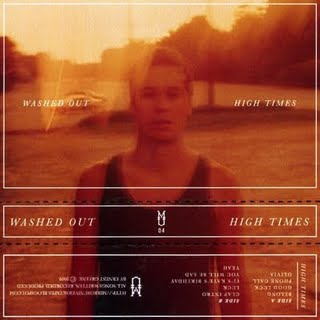
Washed Out
High Times
(Mirror Universe; 2009)
By Calum Marsh | 21 October 2009
Another glo-fi record, another review lamenting the subcultural stagnancy indicated by ____’s unanticipated blogospheric popularity. Twenty-somethings across America combat suburban bedroom ennui with a 4-track and a Myspace page; ravenous bloggers descend, disseminating bootleg rips of cassette-only releases and trumpeting the month-old monikers of their creators; and then when this stuff finally falls upon our jaded critical ears, we quash all hype blithely because suddenly Washed Out or Wavves or Memory Tapes or Best Coast or Gold Panda or Ducktails or whoever-the-fuck-else is nothing less than a portentous affront to standards of good taste, a serious err on the part of all hyping parties to get behind the wrong zeitgeist. It’s potent, concentrated hype that yields potent, concentrated backlash, after all; and, so, in the absence of a more dilatory production and distribution system, I’m left criticizing High Times within three months of Washed Out’s formation—and so you already know that Washed Out is popular, High Times isn’t very good, and you’re prepared to watch me left here struggling with some new and interesting way to explain why yet another shitgaze/glo-fi cassette flounders.
Washed Out specializes in a brand of lo-fi pop music that incites the use of vague descriptors like “gauzy,” “hazy,” “sun-soaked,” and blogger favorite “blissed-out.” But this “glo-fi” pseudo-genre occupies so narrow an aesthetic niche that an accurate description of Washed Out’s style need only allude to conspicuously similar contemporaries: High Times sounds an awful lot like Best Coast’s Where The Boys Are, Memory Tapes’ Seek Magic, Delorean’s Ayrton Senna, and several other 2009 sensations. I guess there’s little to say about these projects without bordering on redundancy because so much of this material seems content to tread shallow water—though that shallowness is admittedly seductive. And I’ve made this point before, as in for Where The Boys Are, I observed that “the chosen aesthetic is, if fundamentally superficial and eventually dull, immensely appealing,” and that remains true here. High Times itself is a pleasant listening experience; it’s just that the pleasantness wears thin, and quickly.
Washed Out’s cosmetic appropriation of a vaguely retro sound makes a pretty hip appeal to nostalgia, and the trick is as limp as it is in hands of other misguided ’80s revivalists. This shoal culture co-opt is trending rampantly and High Times‘s muffled synth washes and campy sample patchwork plays right into the popular mold. But here it’s taken to the extreme, High Times being a cassette-only release limited to 200 copies with no immediate plans for a future digital version. Given that people are actively seeking this music and are perfectly willing to pay for it, and given too the dubious nature of deliberately “punk rock” cassette exclusives (and given, furthermore, that the internet-savvy have made this album widely available through P2P networks, cassette-ripping blogs, and good ole fashioned Google searches, effectively undermining the release-exclusivity’s function of keeping the album, um, exclusive), what, exactly, is the point of releasing the album this way?
Must be the nostalgia trip. But what’s unclear is where this nostalgic fascination comes from and to what end it’s employed here and elsewhere. How does High Times benefit from its own affected cheapness and age? I’m not sure the question has been seriously considered, and now that the hype machine has taken hold of Washed Out, the product’s been digested and exhausted before anyone can give it much thought.





